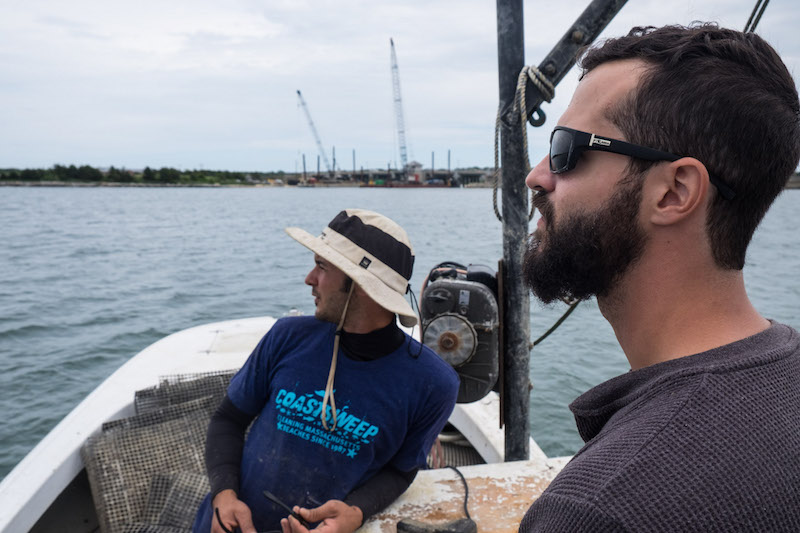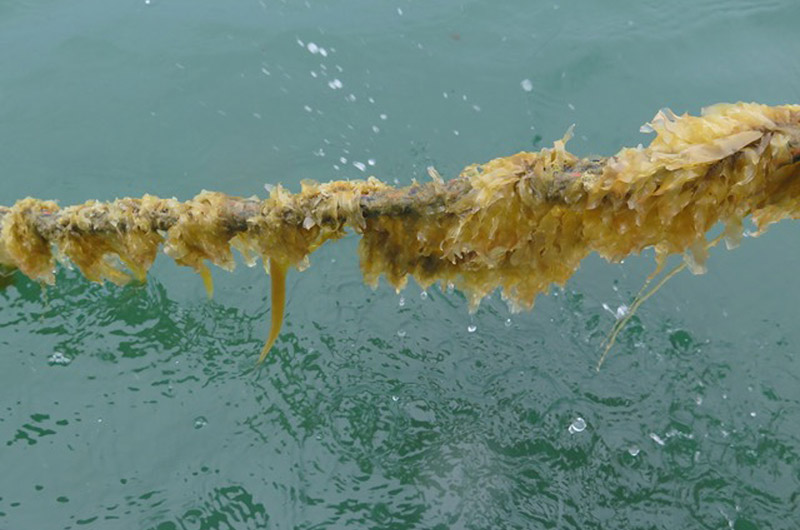Island-sourced kelp salads could soon join farm-raised meat or Chilmark mussels on Vineyard plates, with the state’s first two commercial seaweed permits issued this winter to Martha’s Vineyard shellfishermen.
Oak Bluffs oyster farmers Dan and Greg Martino and Chilmark shellfisherman Stanley Larsen hold commercial kelp permits, pioneers in what’s seen as a growing industry around the world. But the fishermen and state regulators said they are wading into the kelp market slowly, and it might be awhile before a thriving business emerges on the Vineyard or elsewhere in the commonwealth.
Kelp is touted as a super food that can be added to smoothies or salads, and it is often used in beauty products. Some say it could also be used as an alternative biofuel. The plant is also praised as a sustainable crop that can benefit the ocean environment and easily join oysters and mussels underwater in aquaculture farms.
The Martha’s Vineyard Shellfish Group has been growing kelp experimentally for the last few years, by deploying kelp spores on lines of rope and letting them grow. One of the test sites was the Martinos’ oyster farm off Eastville beach in Oak Bluffs.
Greg Martino said growing kelp was a way to diversify their crops. “We were just gung-ho on kelp, even while working with the oysters,” he said. “We really believe that not only should we be growing proteins and stuff like that, but obviously taking advantage of the vegetation aspect too, maximize the water column.”
Kelp is also a cold-water crop, growing during the winter season when oysters are not.

The first step was carving out permitting and regulations for the state’s first commercial seaweed industry, a work still in progress. The Martinos worked with former state Rep. Tim Madden and reached out to officials at the Department of Marine Fisheries.
“We don’t have a licensing structure for seaweed,” state fisheries biologist Christopher Schillaci said recently. The department has been developing a framework for the new crop, working closely with Connecticut and Maine, where regulations are in place.
The seaweed permits awarded on the Vineyard went to existing aquaculturists, who already have permitted areas to grow shellfish. While the areas had already been assessed for environmental impacts, food safety is a different issue, and for all its promise, kelp presents unique questions and some concerns.
“Do we treat it more like a land-based crop, or because it’s coming from the water and there are impacts and potential pollution issues...do we treat it more like seafood,” Mr. Schillaci said. Research is ongoing about health regulations and potential hazards. Right now the state is using the shellfish regulations, which are strict when it comes to food safety, as a guideline.
If managed incorrectly, kelp farming could increase marine debris. Mr. Schillaci said. One source of concern is whale entanglement, with the kelp growing season coinciding with the time of year right whales congregate in Cape Cod waters. Mr. Schillaci said the DMF is moving slowly before permitting any kelp growth in Cape Cod Bay during the whale season.
While Mr. Schillaci and state regulators have put in time to develop the new commercial crop, Mr. Schillaci said it is unclear how large the market is in Massachusetts, especially compared to more competitive markets in Asia and elsewhere. Kelp has a short shelf life, too, he said, and most harvesters have found more success in processing it, like freezing it in cubes that can be used in smoothies. An infrastructure for processing kelp also needs to be developed.
But for all the questions, the state has supported the fledgling kelp effort.
“We need people to grow to find out,” Mr. Schillaci said. “This is why DMF was really supportive of the effort...these are pilot efforts that are going to help us develop a future industry and work out the kinks.”
“I’m a little less optimistic that oysters and kelp are going to solve nitrogen problems,” he added. “But it certainly joins shellfish in the sense that if properly managed it can provide benefits to the environment, which is very different than most crops.”
The Vineyard fishermen too are moving slowly, and focusing more on their main crops. The Martinos’ Cottage City Oysters sold out of oysters in its first harvest last year. While kelp lines have been deployed this year on the farm, “we’re still trying to debate to what extent we really want to go into it,” Greg Martino said. More than anything, he said, the groundwork and experimentation is there for when he or others want to dive into ocean farming.
“When demand is really there we hope to jump into it with both feet,” he added.
The experimental crops in Oak Bluffs have shown that varying water conditions affect kelp flavors, sizes and growth. “We’re using the same sugar kelp, but it’s growing differently on our site,” he said. “Everyone’s getting something different.”
Elsewhere in the state, experimental projects are also taking root, including one by a schoolteacher on Cuttyhunk.
Mr. Larsen, who owns the Menemsha Fish Market, has a commercial permit to grow sugar kelp in Vineyard Sound off Chilmark, in the area where he operates the only blue mussel farm in the state. Both initiatives are new and Mr. Larsen said he too is learning by trial and error. “It’s a pretty rough area for trying to farm things,” Mr. Larsen said, noting the strong-running tides and wind.
“It’s all new to me,” he added.
So far the kelp is getting five-star reviews, at least from those who have ample opportunity to taste it.
“It kind of tastes like a snow pea. It has a nice flavor,” Greg Martino said. “It doesn’t have a fishy taste.”
“It’s great,” Mr. Schillaci said, adding that it is a good source of iodine.
Mr. Larsen said he attended a tasting with a menu that included clams casino and stuffed clams with kelp added to the recipes, and a kelp salad. “I thought it was pretty good,” he said. Eventually kelp or kelp products might be available at his year-round Menemsha fish market. He has also been feeding seaweed to his chickens, he said. “They seem to like it,” he said.
“Aquaculture is going to be a future industry here,” Mr. Larsen said. “I think that’s the whole thing right now, trying to get it all working.”








Comments (2)
Comments
Comment policy »